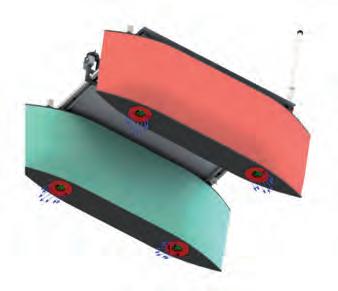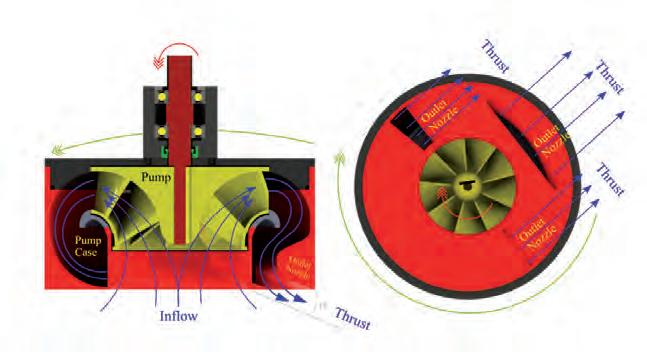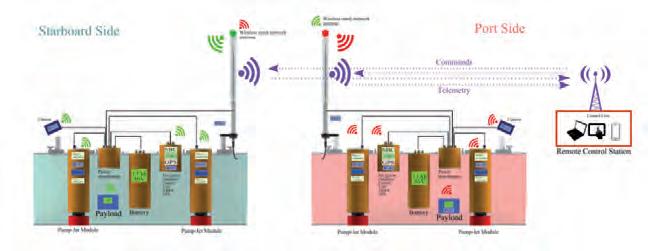
10 minute read
Portable ASV for Extremely Shallow Waters
A Modular and Lightweight Solution for Multipurpose Surveys
SWAMP (Shallow Water Autonomous Multipurpose Platform) is a new autonomous surface vehicle (ASV) whose design and development forms the foundation for an innovative class of highly modular and reconfigurable lightweight ASVs, expressly intended for operation in remote areas and extremely shallow waters. Its design is based on a holistic approach involving different aspects of robotics: the use of innovative and soft materials to protect the propulsion system, electronics and sensors; the design of pump jet propulsion modules contained within the hull; and a modular hardware/ software architecture for a multi-agent distributed guidance, navigation and control (GNC) system.
Coastal waters, swamps, lakes and rivers with their mouths and deltas and tidal freshwaters, generally known as wetlands, are considered to be an important natural resource that require continuous protection and monitoring. Various national and international directives, laws and conventions focus on wetland protection, monitoring and maintenance. Regional administrations are often obliged to perform environmental monitoring in these areas, and the acquisition of data to map wetland ecosystems and to assess their change over time represents a key step in their environmental protection. Nevertheless, the number, quality and spatial resolution of surveys in these environments are limited by a lack of suitable tools. In this framework, the use of robotic-aided solutions can increase the precision and the quality of the surveys and enable the performance of tasks in areas where access is dangerous or difficult. Because water sampling, limnological surveys, bathymetric analysis and water quality monitoring are complicated by difficulties in accessing extremely shallow waters, the use of traditional ASVs results in approximate and inefficient surveys. Most research results point to the lack of hydrographic vessels capable of carrying out measurements in shallow waters at depths of less than one metre.
The SWAMP vehicle in operation in extremely shallow water with a single beam sonar payload.
A Solution for ExtrEmEly ShAllow wAtErS
SWAMP arises from the idea of creating a portable robotic tool for carrying out operations in wetlands. The first prototype was designed and built in the framework of a cooperation between the Institute of Marine Engineering of the Italian National Research Council (CNR-INM) and the Electrical, Electronics and Telecommunication Engineering and Naval Architecture Department of the University of Genoa (DITEN-UNIGE), to find a solution for the problem of extending operations into extremely shallow waters.
rEquirEmEntS
The SWAMP design arose from the idea that a vehicle for extremely shallow waters should meet a number of requirements, in addition to standard ASV requirements. In particular, the vehicle needed to be modular so that it could be used for multipurpose surveys. To achieve this, it needed to have an open hardware and software architecture, to make it possible to easily mount different payloads in different working configurations. A catamaran-like structure with a high payload area was therefore thought to be a good idea. Furthermore, as access to some wetland areas is only possible by foot or with a small car, or by boat or helicopter, the vehicle needed to be compact and easily transportable by hand. Moreover, it needed to be able to access restricted spaces


The SWAMP propulsion system layout. Working principle of the pump jet.
with good controllability and to carry out sampling in the presence of external disturbances (current and wind) and for at least two to four hours. The propulsion units also needed to be able to operate in very shallow waters without the risk of damage, for example from grounding, vegetation or ice. In many cases, it is the adoption of inadequate propulsion units that reduces the operative area of vehicles (“I won’t go there because I don’t
want to lose the vehicle”). In addition, since the vehicle might be deployed in harsh environments, the hull structure, the system of propulsion and the sensor supports were designed and built taking into account the possible impact of the vehicle with stones, shores, roots or other objects that can damage a fragile structure, with consequent loss of the vehicle or damage to the sensors. Finally, the vehicle itself had to have a minimum impact on the surveyed environment, requiring the use of inert materials, electrical power and reduced noise levels.
SWAMP was developed in response to a perceived lack of a light and portable robotic vehicle able to easily access extremely shallow waters
VEhiClE dESCription
The SWAMP vehicle was designed to find a good balance between all of the requirements. SWAMP is a fully electric catamaran, 1.23m long with a design breadth of 1.1m that, by adopting a sliding structure, can be varied between 0.7m and 1.25m. The hull height is 0.4m and the vehicle including structure and antennas is 1.1m high. SWAMP is lightweight at 38kg and has a draft of 0.1m. The standard maximum payload is 20kg with a maximum design draft of 0.14m, but the reserve of buoyancy allows SWAMP to take on up to 60kg with a draft of 0.22m. The small dimensions of the vehicle comply with the idea of a reduced logistics. The hull shape is inspired by the
double-ended Wigley series but with a flat bottom. The double-ended hull form and propulsion system is characterized by equally efficient sailing ahead and astern, with the possibility of manoeuvring in narrow spaces. The hull configuration shape was chosen both for hosting four pump jet type 360° azimuth thrusters expressly designed and studied for this project, and to create an innovative structure. Indeed, one of the main characteristic aspects of SWAMP is its light, soft and impact-survival flexible structure made with a sandwich of soft closed-cell HDPE foam, HDPE plates and pultruded bars. With this design, SWAMP is a completely modular vehicle that can be dismounted and transported to be remounted in various possible configurations. This design allows it to host various types of tools, thrusters, control systems, samplers and sensors. The soft hull allows the vehicle to survive in the case of impact and protects sensors and tools present inside the hull. Moreover, the closed-cell foam gives a high reserve of buoyancy.
The propulsion choice fell on a modular propulsion unit based on pump jets that can be easily installed on the vehicle and that contain all of the electronic control boards. Such a solution also allows the removal, if necessary, of some of the thrusters and/or their substitution with sensors, tools or even other thrust units. Using four azimuth thrusters gives SWAMP the controllability that is required for high-quality surveys. The vehicle also has path-following and dynamic positioning capabilities.
The pump jet operates on the principle of a vertical axis pump and produces thrust through a nozzle contained in the silhouette of the hull. Compared with classical water jet propulsion, the pump jet is characterized by lower operative speeds, higher structural integrity due to the total integration in the hull, and higher manoeuvrability thanks to 360° steering ability. The main advantage of using pump jets is the maximum thrust at minimum draft, and the fact that they can be used as a main thruster and manoeuvring thruster.
One of the main characteristics of SWAMP is that each hull is conceived to be a single vehicle with its own propulsion, GNC unit and power system from a Li-ion battery. Each monohull results in an ASV in itself and, thanks to the azimuth thrusters, is also highly controllable. Moreover, the intelligent core of each vehicle controls the monohull but is able to take over the control of the entire vehicle in the event of failure of the other core. This possibility is guaranteed by the existence of a

The hardware control system and the architectural scheme of SWAMP.
distributed, Wi-Fi-based communication architecture.
The SWAMP hulls were tested, also in shallow water, in the DITEN-UNIGE towing tank at various depths, payloads and breadths. The maximum speed of SWAMP at maximum payload in deep water is 1.6m/s, while the speed in extremely shallow waters down to 200mm (i.e. 60mm of under-keel water) is reduced to 1m/s due to the change in hydrodynamic characteristics in shallow waters.
The software architecture of SWAMP is based on COTS (commercial off-the-shelf)
components. One of the main hardware innovations introduced in SWAMP is the elimination of most of the required wiring by reducing the number of wires to just the ones used for power connections. The basic GNC package of each hull is composed of an IMU and a GPS. Communication is guaranteed by one communication module present in each hull that provides a communication framework for both its own hull and for the other hull modules when required.
The SWAMP vehicle can be remotely controlled and can work autonomously with the help of the GPS, IMU and other sensors mounted onboard.
The SWAMP vehicle can can work autonomously with the help of the GPS, IMU and other sensors mounted onboard
ConClusion
SWAMP was developed in response to a perceived lack, identified through interactions with stakeholders, of a light and portable robotic vehicle able to easily and efficiently access extremely shallow waters. The operational requirements were listed in the initial stage of design with a ‘requirement-based’ project, and in the end all of these requirements were met. The vehicle and its control unit are portable, its dimensions comply with small size and shallow water, and the vehicle is easily deployable. Its structure can withstand external loads and impacts and the propulsion system is suitable for working in extremely shallow water. Moreover, the vehicle is modular and reconfigurable, also in its hardware and software architecture. This concept is important, not only to comply with the various tasks that it may carry out, but also for satisfying the different requirements coming from the same mission.
The vehicle is also fully controllable thanks to its four azimuth thrusters.
As a collateral result, although the vehicle was studied to solve the problem of monitoring wetlands, the SWAMP class of ASVs will be able to support, as a test bed, research in various aspects of marine engineering and robotics, such as propulsion systems, mechanical structures, artificial intelligence, cooperative distributed controls, GNC systems and innovative technological solutions in terms of communications, materials, sensors and actuators.
ACknowledgements
Special thanks go to Marco Altosole, Marco Bibuli, Giorgio Bruzzone, Roberta Ferretti, Mauro Giacopelli, Edoardo Spirandelli, Michele Viviani and Enrica Zereik, who played an important role in the design, development and field testing of the SWAMP vehicle.
References
A. Odetti, G. Bruzzone, M. Altosole, M. Viviani, and M. Caccia. Swamp, an autonomous surface vehicle expressly designed for extremely shallow waters. Ocean Engineering, 216: 108205, 2020. ISSN 0029-8018. doi:https://doi. org/10.1016/j.oceaneng.2020 A. Odetti, M. Altosole, M. Bibuli, G. Bruzzone, M. Caccia, and M. Viviani. Advance speed-hull-pump-jet interactions in small ASV. In Proceedings of 12th Symposium on High Speed Marine Vehicle (HSMV) Conference, Naples, Italy, Volume 1. IOS Press, 2020 A. Odetti, M. Altosole, G. Bruzzone, M. Caccia, and M. Viviani. Design and construction of a modular pump-jet thruster for autonomous surface vehicle operations in extremely shallow water. Journal of Marine Science and Engineering, 7(7):222, 2019
Videos:
Roja River (Italy) survey with SWAMP: https://youtu.be/cedv-E-M79U BTS sea trials: https://youtu.be/ccKQ4c03yIo Towing tank trials on SWAMP hull: https://youtu.be/DHTdHpaEtKM Citizen engagement in science and engineering experiment: https://youtu.be/nozHpp1TneQ
Angelo Odetti, PhD, Marine Engineer and Naval Architect With experience in air cushion technology, Angelo Odetti joined CNR-INM in 2013. His research is based on the development of new concept vehicles for access in remote areas. He is the designer of the hybrid (ROV-AUV) e-URoPe, P2ROV and PROTEUS vehicles, and the ASV SWAMP and samplers, tools and actuators.
Gabriele Bruzzone, Senior Researcher Gabriele Bruzzone received a degree with distinction in Electronic Engineering from the University of Genoa in 1993. Since 1996, he has been working as a researcher at CNR-INM, and as a senior researcher since 2010. In 2015, he became head of the Marine Robotics research group.
Massimo Caccia, Senior Researcher Massimo Caccia’s research focuses on the design, development and application of cooperative unmanned marine vehicles. He is currently prime investigator in the EMFF-EASME Blue RoSES, Interreg Maritime Italy-France MATRAC-ACP and PON ARES projects.






